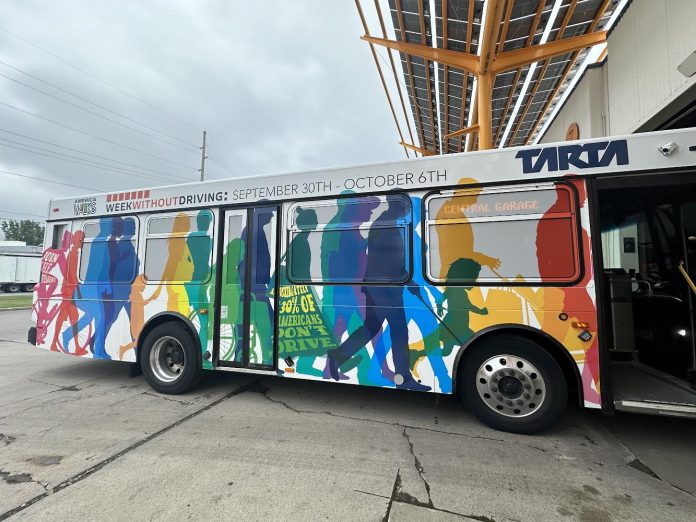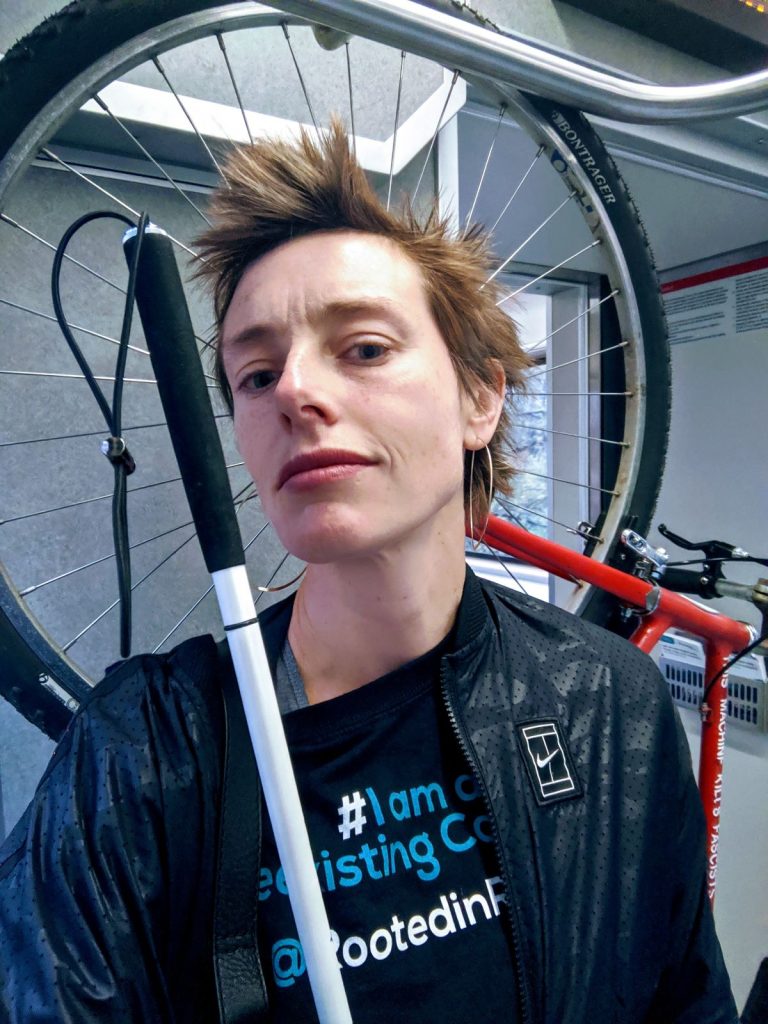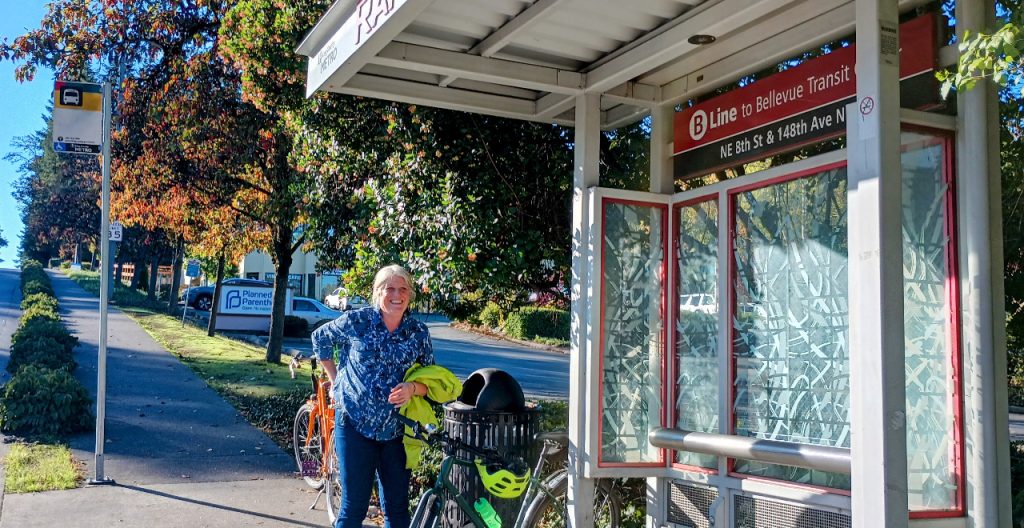
This week, officials and advocates nationwide are participating in the Week Without Driving Challenge. The event has grown to all 50 states in the union, but it has its origins in Washington state as the brainchild of Anna Zivarts, an organizer with Disability Rights Washington and director of its Disability Mobility Initiative.
“It has really exploded,” Zivarts said. “The latest I’ve heard is that more than 400 organizations have participants and are co-hosting in all 50 states, which is just kind of mind blowing.”
The genesis of Week Without Driving was in 2020, when organizing had switched to a largely virtual format due to the pandemic. Disability Rights Washington was seeking more funding for sidewalks and other infrastructure for people walking, rolling, and driving. However, advocates kept bumping up against resistance due to the conventional wisdom that pedestrian infrastructure was a niche issue and the assumption among many policymakers that nearly everyone drives to get around.
“I launched our Transportation Access for Everyone story map project in December 2020, because it felt important to show that there were lots of nondrivers out there,” Zivarts said. “As I moved back to Washington state and started to meet a lot of other disabled folks at Disability Rights Washington who were either employees, staff members, or just community members, I hadn’t realized there were so many other people who couldn’t drive, and so it felt really affirming to meet those people. So, we started doing the organizing.”

Disability Rights Washington could point to statistics that one third of people living in the United States do not have a driver’s license, but gathering personal stories was also a powerful tool to motivate them to think differently, as was getting policymakers to experience other forms of mobility firsthand.
“I wanted to collect those stories in the story map, to show that there were a lot of people,” Zivarts said. “Also to prove to myself that this was real, and then as a political tool as well, right, to be able to go to elected leaders, and when they said things like, ‘oh, everyone in my district drives’ have a very [obvious rebuttal.]”

The story map project morphed into the first run of the Week Without Driving Challenge in 2021. The first year’s participants were largely already allies to the transit and disability rights movements, Zivarts said, but since the challenge to not drive lasted a whole week, it put those leaders in the position to bus, bike, walk, or arrange a carpool even in situations when it was inconvenient and time-consuming — the reality for nondrivers every day.
Day three of the #WeekWithoutDriving. How it’s going: change of plans. pic.twitter.com/2ymhuUOAKy
— Claudia Balducci (@KccClaudia) October 1, 2024
“Gearing the reflections from the elected leaders who did it that first year really affirmed to me that it was important, because many of those folks who did it the first year were people who were our allies already in many ways,” Zivarts said. “People who like transit and would bike places and would take the bus when they could, but for them [it was eye-opening] to experience what it was like to take the bus all the time on those trips that are the trips when it’s not so easy, like on the weekends and the evenings, when it’s raining, or to experience some of the really abysmal sidewalk conditions when you don’t have the choice of driving.”
Ever wondered what life is like without a car? The challenge starts today – and our General Manager, Michelle Allison, is all in. Are you? Learn more at https://t.co/lnZWUiIwQc. #WeekWithoutDriving@americawalks pic.twitter.com/WQV6MKRBiS
— King County Metro 🚏 (@KingCountyMetro) September 30, 2024
Week Without Driving grew exponentially, with only a dozen or so elected officials the first year, but about six times as many the second year. The second year is also when Zivarts began to notice national interest in hosting the challenge.
“Then it grew from there, from around a dozen elected officials the first year, I think we had a closer to 75 the second year, from across the state,” Zivarts said. “That second year, we started getting a lot of emails from people from other states. And they were like, ‘can you help us do it in our state?’ And I was like, ‘oh my gosh, I wish. But, my funding is Washington-state-specific. I don’t have the capacity to do this nationally.’”
As the name suggests, Disability Rights Washington has a clearly delineated state focus. However, in hopes of finding a national boost, Zivarts reached out to former Seattle Mayor Mike McGinn, who has been at the helm at the national pedestrian advocacy nonprofit America Walks since 2020.
Greenways > freeways.
— East Coast Greenway (@ECGreenway) October 1, 2024
Together, we can create greenways and accessible communities for all.
Take the challenge and learn more about @AmericaWalks' #WeekWithoutDriving!https://t.co/u6R909YZ7U pic.twitter.com/1Qu5LfZdZO
“That’s when I started talking to Mike McGinn and trying to figure out if there was a way for him to support it as a national program, and he said yes, and hired Ruth Rosas, who’s an incredible, very organized organizer and terrific communicator,” Zivarts continued. “So, she has been building that national work now within the America Walks coalition, and we’ve been supporting that as much as we can.”
In May, Zivarts published a book called “When Driving Isn’t an Option: Steering Away from Car Dependency,” and she said that allowed her opportunities to do organizing in other states as she tours the country for events promoting the book.
Challenges / Learnings:
— Aurin Chowdhury Council Member W12 (@aurinmpls) October 2, 2024
Planning today required more time than I had. I’m glad I had someone from the same workplace able to give me a ride that was on the way and I wish that I had ample of enough time plan a transit route, but meetings go long, will try again today!
Rural, sparsely-populated states were some of the last ones for organizers to tackle and find participants for the Week Without Driving. Disability groups ended up being key to making inroads in those states.
“There may not be super active like bike walk groups in say Wyoming or South Dakota, but there’s disability groups everywhere and disability support groups,” Zivarts said. “So I reached out through our national network, to some of the states that we’d had a harder time reaching transportation advocates in. And it was kind of cool; basically no one said no, because in every single state transportation access for people with disabilities is a big, big challenge.”
Neighborhood advocates, transportation planners, and community members gathered for a #WeekWithoutDriving Walking & Rolling Tour of Rainier Ave S to discuss ongoing safety issues and opportunities for improvements along Rainier Ave S near the future Judkins Park Station. pic.twitter.com/e5aW67QFnj
— Seattle Greenways (@SNGreenways) October 2, 2024
The Week Without Driving is not about promoting a specific set of policies. Rather, it is a general awareness-raising campaign that seeks to shift paradigms in a way that could create more fertile ground for policy changes down the line. Local groups can tie it to their specific campaign, but the national organization does not. Keeping it general allows wide latitude for public agencies and 501(c)(3) nonprofits to participate.
“The nice thing about it, and we want to make sure it stays this way, is that we’re not tying Week Without Driving to specific federal or local policy,” Zivarts said. “Local groups can do that. Federal advocacy groups can do that, but the Week Without Driving Challenge as a thing can be something that a transit agency can endorse and participate in, right? Because it doesn’t have a policy ask attached to it that would [preclude] or limit their ability to participate as a public agency.”
It’s not too late to jump aboard, Week Without Driving Challenge runs through Sunday, October 4 and will be back next year. Sign up and get more information on the website.
Doug Trumm is publisher of The Urbanist. An Urbanist writer since 2015, he dreams of pedestrian streets, bus lanes, and a mass-timber building spree to end our housing crisis. He graduated from the Evans School of Public Policy and Governance at the University of Washington in 2019. He lives in Seattle's Fremont neighborhood and loves to explore the city by foot and by bike.

